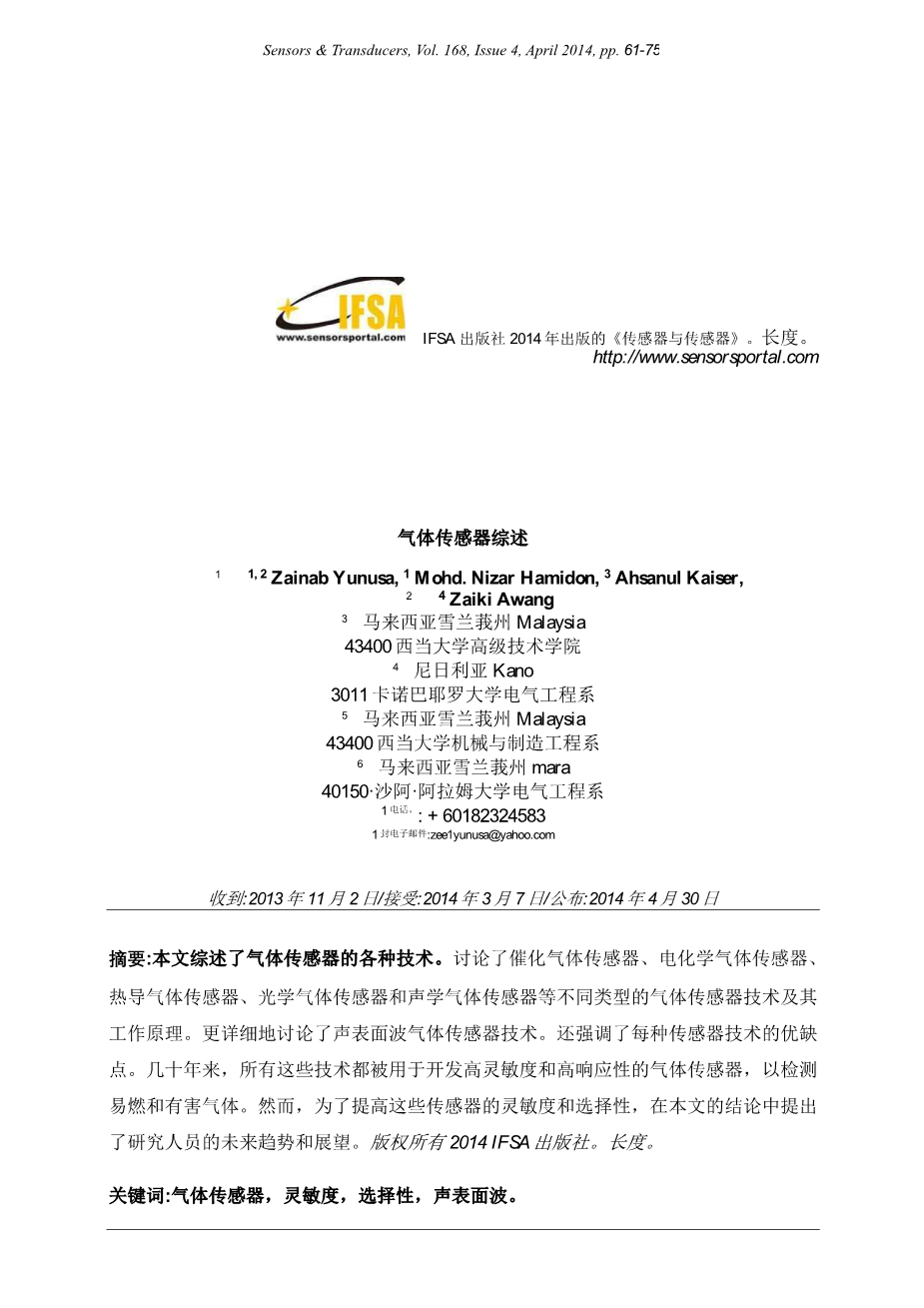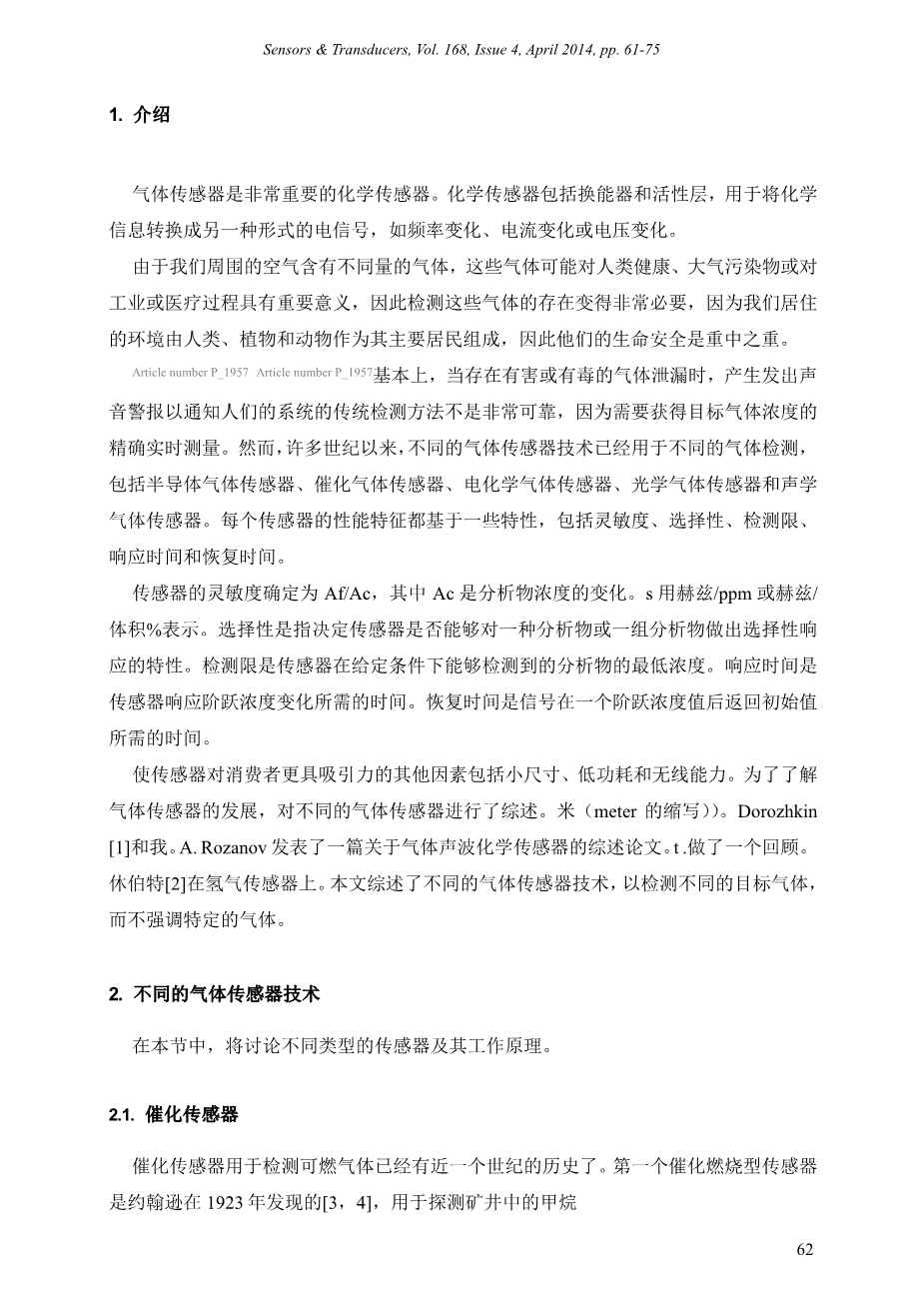气体传感器综述外文翻译资料
2023-08-17 15:22:58
Sensors amp; Transducers copy; 2014 by IFSA Publishing, S. L. http://www.sensorsportal.com
Gas Sensors: A Review
1, 2 Zainab Yunusa, 1 Mohd. Nizar Hamidon, 3 Ahsanul Kaiser,
4 Zaiki Awang
-
Institute of Advanced Technology, Universiti Putra Malaysia
43400 Serdang, Selangor, Malaysia -
Department of Electrical Engineering, Bayero University Kano
3011 Kano, Nigeria -
Department of Mechanical and Manufacturing Engineering, Universiti Putra Malaysia
43400 Serdang, Selangor, Malaysia -
Faculty of Electrical Engineering, Universiti Teknologi MARA
40150 Shah Alam, Selangor, Malaysia
1 Tel.: 60182324583
1 E-mail: zee1yunusa@yahoo.com
Received: 2 November 2013 /Accepted: 7 March 2014 /Published: 30 April 2014
Abstract: In this paper a review of different technologies for gas sensors is presented. The different types of gas sensors technologies including catalytic gas sensor, electrochemical gas sensors, thermal conductivity gas sensor, optical gas sensor and acoustic gas sensor are discussed together with their principle of operation. The Surface Acoustic Wave Gas Sensor technology is discussed in greater detail. The advantages and disadvantages of each sensor technology are also highlighted. All these technologies have been used for several decades for the development of highly sensitive and responsive gas sensors for the detection of flammable and hazardous gases. However, for improved sensitivity and selectivity for these sensors, future trends and outlook for researchers are suggested in the conclusion of this article. Copyright copy; 2014 IFSA Publishing, S. L.
Keywords: Gas Sensor, Sensitivity, Selectivity, Surface Acoustic Wave.
- Introduction
Gas sensors are chemical sensors that are of paramount importance. A chemical sensor comprises of a transducer and an active layer for converting the chemical information into another form of electronic signal like frequency change, current change or voltage change.
As the air surrounding us contains different amount of gases which could be hazardous to human health, atmospheric pollutants or of significance to an industrial or medical process, It becomes therefore very imperative to detect the presence of these gases since the environment we dwell in consists of humans, plants and animals as its main inhabitants, so the safety of their lives is of topmost priority.
Basically, traditional detection methods which produce systems that sounds an audio alarm to notify people when there is a gas leakage that is harmful or poisonous is not very reliable because it is required to obtain accurate real-time measurements of the concentration of a target gas. However, for many centuries, different gas sensor technologies have been used for different gases detection including semiconductor gas sensors, catalytic gas sensors, electrochemical gas sensors, optical gas sensors and acoustic gas sensors. The performance characteristic of every sensor is based on some properties including sensitivity, selectivity, detection limit, response time and recovery time.
Article number P_1957
61
The sensitivity (S) of a sensor is determined as Af/Ac, where Ac is the change in analyte concentration. S is expressed in terms of Hz/ppm or Hz/vol %. Selectivity refers to the characteristics that determine whether a sensor can respond selectively to an analyte or a group of analytes. Detection limit is the lowest concentration of the analyte that can be detected by the sensor under given conditions. Response time is the time it takes for the sensor to respond to a step concentration change. Recovery time is the time it takes for the signal to return to its initial value after a step concentration value.
Other factors that makes a sensor more attractive to consumers include small size, low power consumption and capability of being wireless. In order to have knowledge on development of gas sensors, Some reviews have been made on different gas sensors, L. M. Dorozhkin [1] and I. A. Rozanov made a review paper on acoustic wave chemical sensors for gases. A review was made by T. Hubert [2] on Hydrogen gas sensors. In this paper, a review of different gas sensor technologies is presented for the detection of different target gases without emphasis on a particular gas.
- Different Gas Sensor Technologies
In this section a review on the different types of sensors and their principle of operation will be discussed.
-
- Catalytic Sensors
Catalytic sensors have been in use for almost a century for the detection of combustible gases. The first catalytic combustion type sensor was discovered by Jonson in 1923 [3, 4] and was used for the detection of methane in mines
-
-
- Principle of Operation
-
Most metal oxides and their compounds possess catalytic property. Combustible gas mixtures do not burn until they attain a certain ignition temperature, but in the presence of a particular chemical process the gas will begin to
剩余内容已隐藏,支付完成后下载完整资料


英语译文共 29 页,剩余内容已隐藏,支付完成后下载完整资料
资料编号:[606084],资料为PDF文档或Word文档,PDF文档可免费转换为Word




